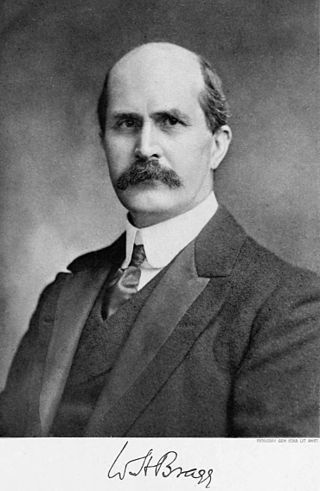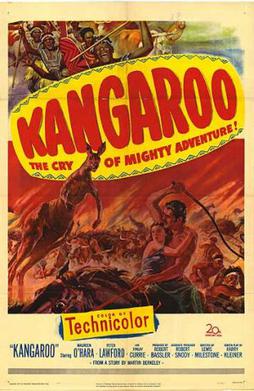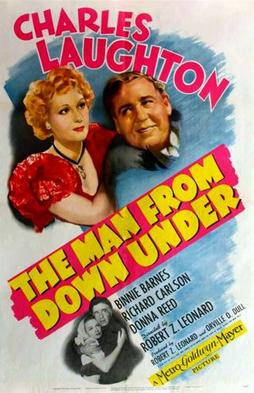Related Research Articles

Sir William Henry Bragg was an English physicist, chemist, mathematician, and active sportsman who uniquely shared a Nobel Prize with his son Lawrence Bragg – the 1915 Nobel Prize in Physics: "for their services in the analysis of crystal structure by means of X-rays". The mineral Braggite is named after him and his son. He was knighted in 1920.

John Villiers Farrow, KGCHS was an Australian film director, producer, and screenwriter. Spending a considerable amount of his career in the United States, in 1942 he was nominated for the Academy Award for Best Director for Wake Island, and in 1957 he won the Academy Award for Best Adapted Screenplay for Around the World in Eighty Days. He had seven children by his wife, actress Maureen O'Sullivan, including actress Mia Farrow.

Norman John Oswald Makin AO was an Australian politician and diplomat. He was an Australian Labor Party member of the Australian House of Representatives from 1919 to 1946 for Hindmarsh, from 1954 to 1955 for Sturt, and from 1955 to 1963 for Bonython. He was Speaker of the Australian House of Representatives from 1929 to 1932 and served as Minister for the Navy, Minister for Munitions (1941–1946) and Minister for Aircraft Production (1945–1946) under John Curtin, Frank Forde and Ben Chifley. He was the first President of the United Nations Security Council in 1946, and served as Ambassador to the United States from 1946 to 1951.

Cinesound Productions Pty Ltd was an Australian feature film production company. Established in June 1931, Cinesound developed out of a group of companies centred on Greater Union Theatres that covered all facets of the film process, from production to distribution and exhibition. Cinesound Productions established a film studio as a subsidiary of Greater Union Theatres Pty Ltd based on the Hollywood model. The first production was On Our Selection (1932), which was an enormous financial success.
Douglas Wilkie was an Australian journalist, a respected columnist for The Sun News-Pictorial.

John F. Gavin was a pioneer Australian film actor and director, one of the early filmmakers of the 1910s. He is best known for making films about bushrangers such as Captain Thunderbolt, Captain Moonlite, Ben Hall and Frank Gardiner. Known informally as 'Jack', Gavin worked in collaboration with his wife Agnes, who scripted many of his films.

George Edwin Yates, often referred to as Gunner Yates, was an Australian politician. He was an Australian Labor Party member of the Australian House of Representatives from 1914 to 1919 and from 1922 to 1931, representing the electorate of Adelaide.

Roland Pertwee was an English playwright, film and television screenwriter, director and actor. He was the father of Doctor Who actor Jon Pertwee and playwright and screenwriter Michael Pertwee. He was also the second cousin of actor Bill Pertwee and grandfather of actors Sean Pertwee and Dariel Pertwee.

Bitter Springs is a 1950 Australian–British film directed by Ralph Smart and starring Tommy Trinder, Chips Rafferty and Gordon Jackson.

Kangaroo is a 1952 American Western film directed by Lewis Milestone. It was the first Technicolor film filmed on location in Australia. Milestone called it "an underrated picture."

The Man from Down Under is an American 1943 drama film starring Charles Laughton as an Australian man who raises two war orphans.
South West Pacific is a 1943 propaganda short Australian film directed by Ken G. Hall which focuses on Australia as the main Allied base in the South West Pacific area. Actors depict a cross section of Australians involved in the war effort.

Alfred Rolfe, real name Alfred Roker, was an Australian stage and film director and actor, best known for being the son-in-law of the celebrated actor-manager Alfred Dampier, with whom he appeared frequently on stage, and for his prolific output as a director during Australia's silent era, including Captain Midnight, the Bush King (1911), Captain Starlight, or Gentleman of the Road (1911) and The Hero of the Dardanelles (1915). Only one of his films as director survives today.
The Herald was a weekly trade union magazine published in Adelaide, South Australia between 1894 and March 1910; for the first four years titled The Weekly Herald. It was succeeded by The Daily Herald, which ran from 7 March 1910 to 16 June 1924.

William Harold Oliver was an Australian rules footballer. Harold Oliver was a key player to some of South Australian football's most successful teams. He starred in South Australia's victorious 1911 Australian football championship along with Port Adelaide's 1914 "Invincibles" team. After being close to retiring from the game after World War I, he returned to captain both Port Adelaide to the 1921 SAFL premiership and South Australia in a game against Western Australia. His reputation as an early exponent of the spectacular mark—along with his general skill at playing the game—saw him regarded as one of the best players South Australia has produced.
Road to Victory: Milestones in the Struggle for Liberty is a 1941 Australian short documentary directed by Ken G. Hall.
Another Threshold is a 1942 Australian propaganda short film directed by Ken G. Hall and starring Peter Finch.
John Henry Richman was a lawyer in the young British colony of South Australia.

Thomas Playford was a non-conformist minister of religion, teacher and farmer in the early days of the British colony of South Australia. The first-born son of the next three generations were also named Thomas; the second and fourth became premiers of South Australia. His time in South Australia was closely linked with that of his brother, John Playford, sister Hannah Welbourn née Playford (1813–1865), and Hannah's husband Thomas Welbourn (1812–1879).
Ozone Theatres Ltd, formerly Ozone Picture Company and then Ozone Amusements Ltd, was a cinema chain based in Adelaide, South Australia, from 1911 until 1951, when it sold its theatres to Hoyts. It was founded by Hugh Waterman and friends, and was jointly run by him and seven sons, including Clyde Waterman and Sir Ewen McIntyre Waterman. S.A. Theatres and Ozone Theatres were subsidiary companies, and the chain was referred to as the Ozone circuit. It was one of two major film exhibitors in the state from after World War I until the late 1940s, the other being D. Clifford Theatres Limited. After 1938, Ozone dominated the market.
References
- ↑ Pike, Andrew Franklin. "The History of an Australian Film Production Company: Cinesound, 1932-70" (PDF). Australian National University. p. 242.
- ↑ "Screen & Radio Features In Loan Drive". The Sunday Times . Perth. 3 October 1943. p. 8. Retrieved 13 March 2015– via National Library of Australia.
- ↑ "Five Films To Aid Loan". The Advertiser (Adelaide) . Vol. LXXXVI, no. 26516. South Australia. 29 September 1943. p. 7. Retrieved 21 March 2024– via National Library of Australia.
- ↑ "FILM CRITICISED". The Advertiser . Adelaide. 8 November 1943. p. 4. Retrieved 13 March 2015– via National Library of Australia.
- ↑ "POINTS FROM LETTERS". The Advertiser . Adelaide. 10 November 1943. p. 6. Retrieved 13 March 2015– via National Library of Australia.